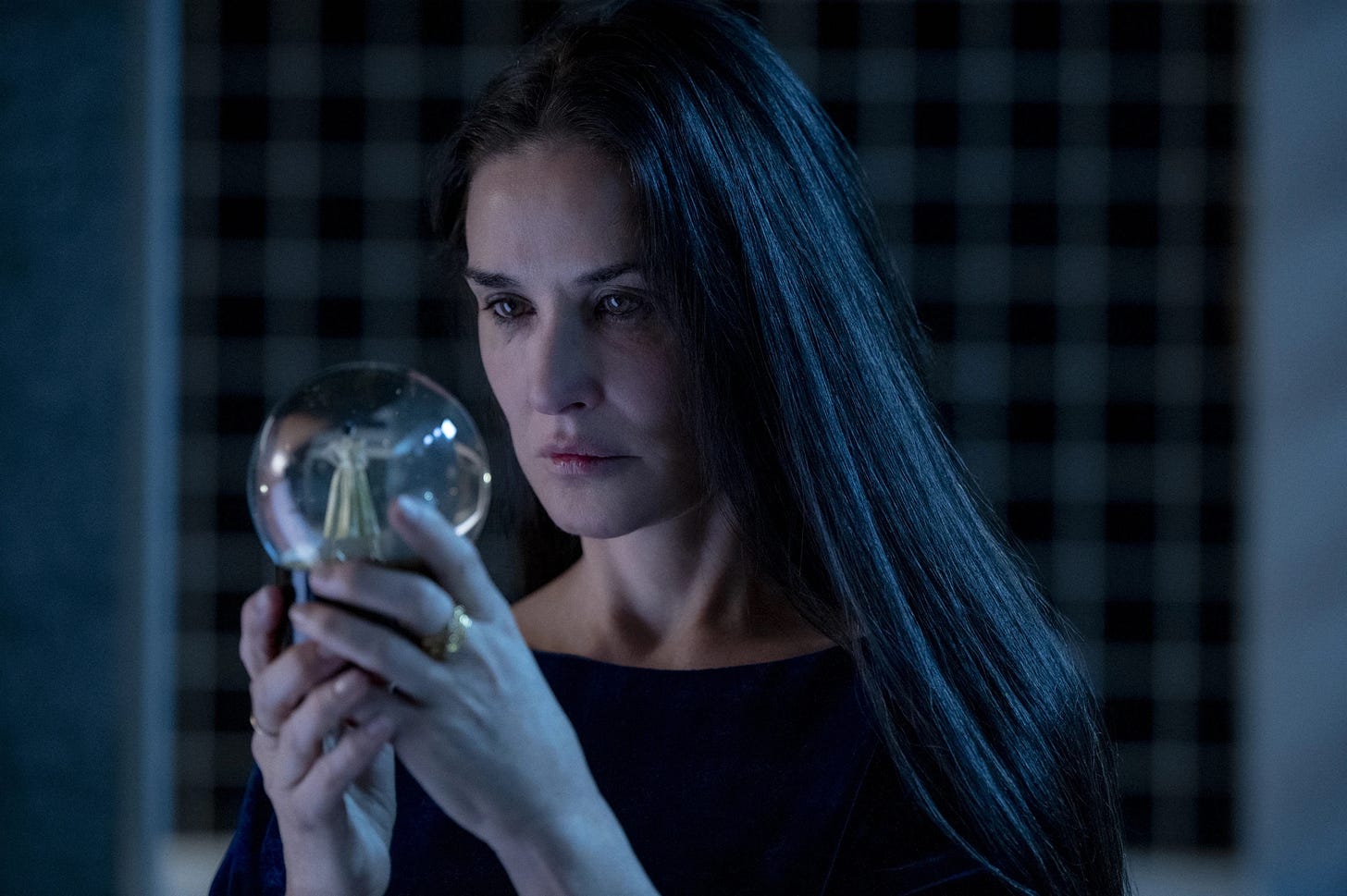'The Substance' Begs The Question: Where Tf Are Your Friends?
The Oscar-nominated film is missing something I couldn’t suspend my disbelief for.

sub_stance on The Substance. You know I had to do it.
This Sunday, Demi Moore is favored to win Best Actress at the Academy Awards for her role in The Substance, a French noir film where an aging star named Elisabeth Sparkle (already so extra) injects herself with a black market drug to birth a younger version of her body. As a meditation on ageism and misogynistic beauty standards, The Substance goes from zany, neoprene and colorful to dank, obsessive and grotesque pretty quickly. It’s anything but subtle.
The movie’s gotten stellar reviews for its screenplay, special effects, cinematography, etc. and Demi has (rightfully) been almost sweeping awards season this year for her portrayal of the role. At this Sunday’s show, it will be her first Oscar nomination in a career that spans four decades. From the discourse the movie has stirred to the redemptive career arc Demi’s gotten from it, it’s all been a tightly-packaged Hollywood hero’s journey. But there’s a few missing stitches my mind’s been picking at.
Admittedly, I was late to The Substance. I watched it at home with my friend, Linda, during the first cozy January weekend of the year. The gore was a lot to process, but wasn’t unbearable. At some points, it was so over-the-top and campy, it teetered on funny. And yes, Demi ate this role up. But fake blood pints and prosthetics aside, there’s a weird, depressing omission from the world of this film that I couldn’t suspend my disbelief for. The major question in my head as the credits rolled was, Where tf were Elisabeth’s friends?
In the midst of her self-indulgent spiral, Elisabeth doesn’t have a single friend – or sister, cousin, scene partner, agent, mentor – to tell her, “Bitch, snap out of it! You’re doing too much!”
Besides her younger counterpart, Sue (played by Margaret Qualley), Elisabeth specifically has very little interaction with other women throughout the film. A stylist here, a production assistant there, a cleaning lady who ignores her rich white lady bs. There’s no one for Elisabeth to call up or text to give her a level check on the dangers of what she’s doing.
Studies show that as we age, priorities and responsibilities shift and we maintain less friendships. Many pinpoint the age range where they start to have children and create their nuclear families as the period where they stop making new friends. That drop off rate increases with each decade of life. In the movie, as soon as Elisabeth turns 50, she’s forced into retirement. As a childless woman who dedicated every fiber to her career, she seemingly doesn’t have any friends or family to show for it. She feels rejected, isolated, lost. If it's internalized misogyny that piques her interest in the substance, her isolation is what propels her out of her apartment to go get it. But now, imagine if somewhere in the mix she dropped a text into a group chat about it. How would the trajectory of the plot change? Yeah, it might’ve been the same – she seemed staunchly determined from jump – but at least there’d be an element of social interaction to counter or confirm her hysteria convictions.
The Substance director, Coralie Fargeat, has said that, “Being a woman is body horror.” It's true. The pressure Elisabeth feels, although magnified to a cartoonish level, is very real. And the scenes where she starts to inject herself with the radioactive green goo feel squirmy, but they’re not that far off from a procedural day in a plastic surgeon's office or a lunchtime botox-and-filler appointment.

By design, the beauty economy and body policing run off our collective fixation on youth. But the difference between The Substance and the society it interrogates is at this point, body modification is far from closeted, solitary work. It’s not completely de-stigmatized, but it's not hushed practice either. Body modification procedures are based on how we’re perceived in the world, so they’re inherently social just as much as psychological. Doctor referrals via TikTok are accepted as legit. Elisabeth, meanwhile, doesn’t even have a practitioner! Just a voice on the phone and some confusing-ass instructions. Patients post BBL and facelift healing journeys on YouTube. Sue pops up as a completely different person, taking Elisabeth’s job and choosing to have no association with the woman from which she spawned. And unlike the film, we’re absolutely dissecting the pros and cons of body modifying treatments like this in our trusted friend groups, not just going off what some sexist boss (played by Dennis Quaid in the film) says about us in a bathroom. The gruesome moments in the movie aren’t far off from the acute realities we face looking back at our own reflections on the daily. The difference is, we have the option to talk about it with each other. Whether you want to change up or not, there’s plenty of communal resources to pull from along the way.
Elisabeth’s manic, one track mind could have been slowed at least a half a beat by adding a dissenting confidante into the sequence. Or, it might have been accelerated into hyperspeed by a friend she encounters on the street who’s loving life as their youthful body double. One wine-and-cigarette driven keke could changed Elisabeth’s whole perspective. Why doesn’t she have any of that? Is it her age? Is it the competitiveness of the business she’s in? Is her having friends realistic for this chaos? I get the character development was not exactly complex for this, but damn. A real human interaction that wasn’t completely ridiculous was a missing fold from a great project about warped social standards.
As Linda and I debriefed on what we just witnessed from my couch back in January, her first response was, “I’m glad I watched this with a woman.” As a feminist film written for women, it felt only right to experience this in an intimate way; With a friend I could be real with. If only Elisabeth had one dose of the same.
In the between time, here’s some other points of connection between friends, film and the bodily form 💭:
Everyone (maybe except for Justin Baldoni) should be sending voice notes to their friends.
I highly recommend reading the three-part substack series Getting A Fat Body Done from Notes From A Trap Feminist. Shout out to Sesali Bowen for her transparency, care and brilliance.
In the transcendent spirit of Roberta Flack, who passed this week, an ode to listening to an old cut in the car with your girls. It’s the second best car scene in the flick. :)






